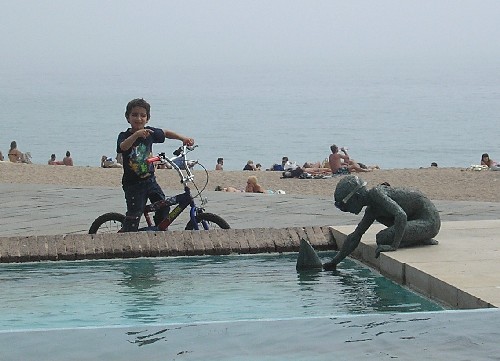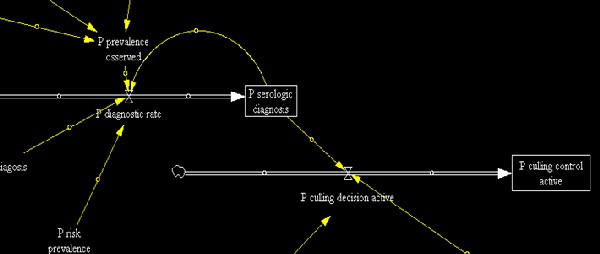One world one health: avian influenza
A System Dynamics Based Model
Giuseppe Noce - DVM PhD
Servizio Salute - Regione Marche
giuseppe.noce@regione.marche.it
Mario Guido Pérez
mariogperez@arnet.com.ar
 The Earth is the place in which animals and people live. This means that people and animals share the same environment creating dynamic, inextricable and interconnected association between them. The connection between humans and animals is getting deeper and deeper and is threatening the health of people. Several new human diseases have appeared and 60% of them are due to pathogens that have been passed among several animals. In the recent decades, 75% of the new human infectious disease have been classified as zoonosis.
Other threats for human health come from the interconnected global community and from bioterrorism. Climate changes may be another threat for health.
The Earth is the place in which animals and people live. This means that people and animals share the same environment creating dynamic, inextricable and interconnected association between them. The connection between humans and animals is getting deeper and deeper and is threatening the health of people. Several new human diseases have appeared and 60% of them are due to pathogens that have been passed among several animals. In the recent decades, 75% of the new human infectious disease have been classified as zoonosis.
Other threats for human health come from the interconnected global community and from bioterrorism. Climate changes may be another threat for health.
The old and traditional approaches may not be commensurate with the new threats. Human and veterinary medicine have to collaborate to guarantee the health of human, because we live in a changing world in which prevention and health promotion in people and in animals are becoming a necessity. The solution may be the convergence of human and veterinary medicine into a new medicine, into one medicine.
This concept is not a new concept. In the beginning of medicine, there was a holistic model dedicated to both human and animal health. In the Middle Age, the tendency to separate the human medicine from the veterinary medicine prevailed. But in the XX century, the disadvantages of this division were emphasized and the concept of one medicine was re-introduced.
The one medicine approach requires a paradigm shift and represents a strategic revolution. It means that the interdisciplinary collaboration among veterinarians, physicians and other health professionals and among multiple health disciplines would forester an improvement in health of people, animals and our environmental. This approach may also increase scientific knowledge.
In this contest, System Dynamics (SD) is very useful. SD allows us to study the effects of various connections of health, to examine the multidisciplinary aspects of health and to consider the threat on animal and human health alloweding us to adopt the integrated, holist approach typical of one medicine.
Avian influenza (AI) represents a threat for human health. AI is a contagious respiratory illness caused by influenza virus and infects animals (such as ducks, waterfowl, poultry, cats, dogs). Through mutation, the same virus can infect humans, too.
The most famous influenza virus is the H5N1 virus. It is able to cause two different forms of disease. One of them is the “low pathogenic avian influenza” (LPAI), which is a mild infectious disease of birds with mild outbreak, so is more easily detected by regular serological test (active surveillance). The second one is ”high pathogenic avian influenza” (HPAI). It is a rare, but lethal disease with high rate of mortality in outbreak.
Migratory birds carry the H5N1 (LPAI) into different regions. By close contact the H5N1 LPAI passes to ducks which transmits the virus to poultry. Poultry may be infected by close contact with migratory birds, but this is not the common way. In poultry, LPAI virus can turn in HPAI virus. HPAI virus spreads rapidly among poultry flocks leading to lethal form of AI. HPAI is able to spread to ducks and to humans (from poultry or ducks). In human, HPAI can again mutate causing a lethal human disease or pandemic disease.
In the epidemiology of AI other animals (such as pigs or other mammals) are involved but they are not a fundamental factor for the spread of AI.
Burak E. and Burak T. (2007) developed a System Dynamics model which is able to describe the complex dynamics of avian influenza epidemics (http://www.systemdynamics.org/conferences/2007/proceed/papers/ESKIC371.pdf). They simulate the dynamics of AI spread using a network of wild-birds, ducks, poultry and human sector formed by several SIR-models. They simulate the mutations from LPAI to HPAI and from HPAI to a pandemic virus.
They developed modified models to add some scenarios and policy analyses to the basic model. However they use a model for each scenario.
I developed a model which includes the base model, each scenario and the policy analyses of Burk E. and Burak T. (2007) as well as the scenario and policy analyses that simulated the Italian active surveillance program. This program establishes the sierological control of breeded bird. If this control point out a number of birds infected over 5%, the birds must put down. Running the model, we can see that when infected birds are put down the probability that humans become infect decreases.
In conclusion SD can improve the synergy among human and veterinary medicine: to create good health practices, which are able to protect humans , animals and their products and environment from health threats.
In this picture i simulate the culling policy after sierological detecting HPAI in poultry. To create my simulation, i modificated the model of Burak Eskici and Burak Turkgulu in which they simulated the Culling poultry After Detection of HPAI. I add the time to perform the collection of sierological samples and the laboratory analisys (P time diagosis) and the HPAI disesase level in poultry (P prevalence osserved). The others variables are the same of the original model of Burak and Burak.
 TRADUCCION AL CASTELLANO
TRADUCCION AL CASTELLANO
La Tierra es el lugar donde viven los animales y los seres humanos. Esto significa que ambos comparten el mismo ambiente, creando asociaciones dinámicas, inextricables e interconectadas. La conexión entre humanos y animales se está haciendo cada vez más cercana, y amenaza la salud de las personas. Han surgido varias nuevas enfermedades humanas, y el 60% de ellas se deben a microorganismos patógenos que se han transmitido entre varios animales. En décadas recientes, el 75% de las nuevas enfermedades infecciosas han sido clasificadas como zoonosis.
Otras amenazas para la salud humana provienen del mundo globalmente interconectado y del bioterrorismo. Los cambios climáticos podrían ser otra amenaza para la salud.
El abordaje antiguo y tradicional no resulta suficiente con las nuevas amenazas. Las medicinas humana y veterinaria deben colaborar para garantizar la salud humana, ya que vivimos en un mundo cambiante en el cual prevenir y promover la salud en humanos y animales se ha vuelto una necesidad. La solución podría ser la convergencia de ambas medicinas, humana y veterinaria, en una única medicina.
Este concepto no es nuevo. En los comienzos de la medicina, había un modelo holístico dedicado tanto a humanos como a animales. En la Edad Media prevaleció la tendencia a separar la medicina humana de la veterinaria. No obstante, en el siglo XX cobraron énfasis las desventajas de esta división y se reintrodujo el concepto de medicina única.
El enfoque de medicina única requiere un cambio de paradigma y representa una revolución estratégica. Significa que la colaboración interdisciplinaria entre veterinarios, médicos y otros profesionales de la salud, así como de las múltiples disciplinas de la salud, favorecerán una mejora de la salud de las personas, animales y el medioambiente. Este enfoque podría asimismo incrementar el conocimiento científico.
En este contexto, la Dinámica de Sistemas (SD) es muy útil. La DS nos permite estudiar los efectos de las diversas conexiones de la salud, examinar sus aspectos multidisciplinarios y considerar las amenazas sobre las salud de humanos y animales permitiéndonos adoptar una enfoque integrado y holístico, típico de la medicina única.
La gripe aviar (avian influenza, AI, en inglés) representa una amenaza para la salud humana. Es una enfermedad respiratoria causada por el virus de la influenza, e infecta a animales (tales como patos, aves acuáticas, pollos, gatos, perros). A través de mutaciones el mismo virus puede infectar también a humanos.
El virus de influenza más conocido es el H5N1. Es capaz de causar dos formas diferentes formas de enfermedad. Una de ellas, la “low pathogenic avian influenza” (LPAI) es una enfermedad infecciosa benigna en pájaros con brotes benignos, por lo que es más fácilmente detectada mediante tests serológicos regulares (vigilancia activa). La segunda es “high pathogenic avian influenza” (HPAI). Esta es una enfermedad rara pero letal, con brotes de una alta tasa de mortalidad.
Las aves migratorias transportan el virus H5N1 a diferentes regiones. Por contacto cercano el H5N1 se transfiere a los patos, los cuales transmiten el virus a los pollos. Los pollos podrían ser directamente infectados por contacto con las aves migratorias, pero esta no es una vía común. En los pollos, el virus LPAI puede evolucionar a virus HPAI. El virus HPAI se expande rápidamente entre los pollos, conduciendo a una forma letal de la gripe aviar (AI). Asimismo, el HPAI es capaz de expandirse a patos y humanos (tanto desde pollos como de patos). En los humanos el virus HPAI puede mutar nuevamente causando una enfermedad humana letal o una enfermedad pandémica.
Otros animales, tales como cerdos u otros mamiferos, pueden verse involucrados en la epidemiologia de la AI, pero no son un factor fundamental de expansión.
Burak E. and Burak T. (2007) desarrollaron un modelo en Dinámica de Sistemas que describe la compleja dinámica de las epidemias de gripe aviar. (http://www.systemdynamics.org/conferences/2007/proceed/papers/ESKIC371.pdf).
Simularon la dinámica de expansion de la gripe aviar mediante una red de aves silvestres, patos, pollos y humanos formada por varios modelos SIR (Susceptible for Infection and Recovering). Tuvieron en cuenta la mutación desde el LPAI al HPAI y desde el HPAI a un virus pandémico.
También desarrollaron modelos modificados para agregar algunos escenarios y análisis estratégicos sobre el modelo básico. No obstante, usaron un modelo para cada escenario.
El presente trabajo desarrolla un modelo que incluye el modelo base, cada escenario y el análisis estrategico de Burk y Burak T (2007), así como el escenario y estrategias que simulan el programa italiano de vigilancia activa. Este programa establece el control serológico de aves reproducidas en cautiverio. Si este programa evidencia un número de aves infectadas superior al 5%, las aves deben ser abatidas. Simulando el modelo podemos ver que cuando las aves infectadas son eliminadas, la probabilidad de que los humanos se infecten disminuye.
En conclusión, la Dinámica de Sistemas puede mejorar la sinergia entre las medicinas humana y veterinaria, crear buenas prácticas sanitarios, capaces de proteger a humanos, animales, sus productos y el medioambiente de las amenazas para la salud.
En este sketch simulo la política de sacrificio depués de la detección serológica en pollos. Para crear esta simulación, modifiqué el modelo de Burak Eskici and Burak Turkgulu en la cual ellos simulan the Culling poultry After Detection of HPAI (Sacrificio de pollos después de la detección del HPAI). Agregué el tiempo para colectar las muestras serológicas y efectuar los análisis de laboratorio (P time diagosis), y el nivel de muertes de HPAI en los pollos )P prevalence osserved). Las demás varialbes son las mismas que en el modelo original de Burak y Burak.
|